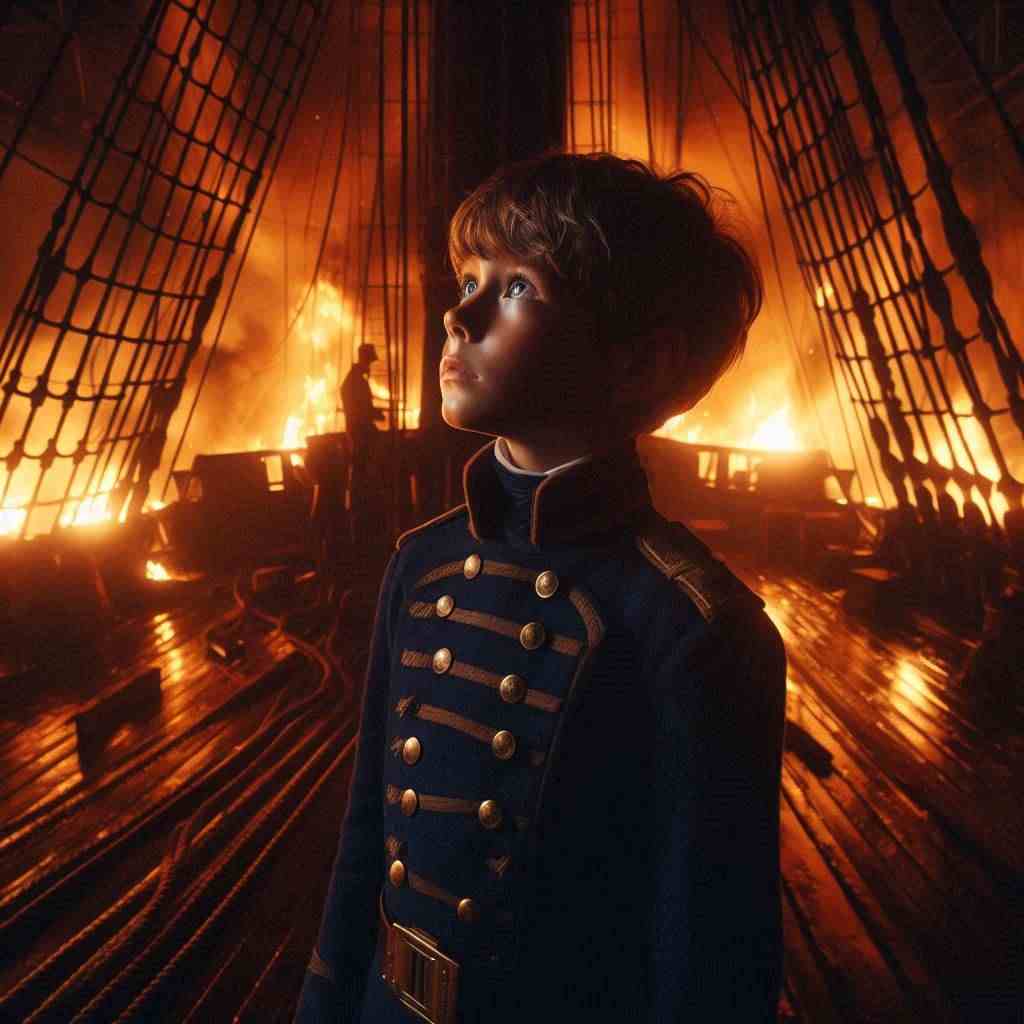Casabianca
Felicia Dorothea Hemans
1793 to 1835

The boy stood on the burning deck
Whence all but him had fled;
The flame that lit the battle's wreck
Shone round him o'er the dead.
Yet beautiful and bright he stood,
As born to rule the storm;
A creature of heroic blood,
A proud, though child-like form.
The flames roll'd on—he would not go
Without his Father's word;
That Father, faint in death below,
His voice no longer heard.
He call'd aloud:—"Say, Father, say
If yet my task is done?"
He knew not that the chieftain lay
Unconscious of his son.
"Speak, Father!" once again he cried
"If I may yet begone!
And"—but the booming shots replied,
And fast the flames roll'd on.
Upon his brow he felt their breath,
And in his waving hair,
And looked from that lone post of death,
In still yet brave despair.
And shouted but once more aloud,
"My Father, must I stay?"
While o'er him fast, through sail and shroud,
The wreathing fires made way,
They wrapt the ship in splendour wild,
They caught the flag on high,
And streamed above the gallant child,
Like banners in the sky.
There came a burst of thunder sound—
The boy—oh! where was he?
Ask of the winds that far around
With fragments strewed the sea!
With mast, and helm, and pennon fair,
That well had borne their part—
But the noblest thing which perished there
Was that young faithful heart!
Felicia Dorothea Hemans's Casabianca
Introduction
Felicia Dorothea Hemans' "Casabianca" stands as a quintessential example of Romantic poetry, embodying the era's preoccupation with heroism, nature's power, and the innocence of youth. This analysis delves into the multifaceted layers of Hemans' work, exploring its historical context, literary devices, thematic richness, and enduring impact on English literature. Through a close reading of the poem's structure, imagery, and symbolism, we will uncover the intricate ways in which Hemans crafts a narrative that is at once a celebration of unwavering loyalty and a poignant critique of war's futility.
Historical Context and Inspiration
"Casabianca" draws its inspiration from a real historical event: the Battle of the Nile in 1798. The poem recounts the story of Louis de Casabianca, a 12-year-old boy who remained at his post on the burning ship L'Orient, awaiting his father's orders even as the vessel was engulfed in flames. This historical backdrop provides a crucial framework for understanding the poem's themes of duty, sacrifice, and the human cost of conflict.
Hemans, writing in the early 19th century, was part of a literary movement that sought to romanticize and memorialize acts of heroism, particularly those involving children. This tendency reflects the Romantic period's fascination with innocence and its belief in the inherent nobility of the human spirit, especially when uncorrupted by societal influences.
Structure and Form
The poem's structure is as disciplined as the young subject it describes. Composed of nine quatrains with an ABAB rhyme scheme, "Casabianca" exhibits a formal rigidity that contrasts sharply with the chaotic scene it depicts. This juxtaposition between form and content serves to heighten the tension within the narrative.
Each stanza is crafted with alternating lines of iambic tetrameter and iambic trimeter, creating a rhythmic pattern that echoes the steadfast heartbeat of the young hero amidst the tumultuous environment. This metronomic quality underscores the boy's unwavering resolve, even as the world around him descends into chaos.
Imagery and Symbolism
Hemans' use of vivid imagery is central to the poem's power. The "burning deck" and the flames that "roll'd on" create a hellish backdrop against which the boy's figure is silhouetted. This fiery imagery serves multiple purposes: it heightens the drama of the scene, symbolizes the destructive nature of war, and acts as a crucible in which the boy's character is tested and ultimately immortalized.
The repeated references to the boy's physical appearance—"beautiful and bright he stood," "A proud, though child-like form"—create a stark contrast with the devastation surrounding him. This juxtaposition of beauty and destruction is a common trope in Romantic poetry, often used to critique the human capacity for both creation and annihilation.
The ship itself becomes a potent symbol throughout the poem. Initially representing order and military might, it transforms into a funeral pyre, highlighting the transient nature of human constructs in the face of nature's fury. The "wreathing fires" that engulf the ship create a twisted sort of coronation for the young hero, ironically crowning him at the moment of his demise.
Themes of Duty and Sacrifice
At its core, "Casabianca" is an exploration of duty and sacrifice. The boy's unwavering obedience to his father's last command, even in the face of certain death, speaks to a conception of honor that may seem alien to modern readers. This absolute adherence to duty raises questions about the nature of heroism and the potential dangers of unquestioning obedience.
The poem can be read as both a celebration of the boy's loyalty and a subtle critique of the systems that would demand such sacrifice from one so young. Hemans invites the reader to consider the cost of war not just in terms of lives lost, but in the corruption of innocence and the perpetuation of values that prioritize duty over self-preservation.
The Role of Nature
Nature plays a dual role in "Casabianca," serving both as an indifferent backdrop to human tragedy and as an active participant in the unfolding drama. The sea, which surrounds the burning ship, represents the vastness and impartiality of the natural world. It is both a witness to the boy's heroism and the final resting place for the fragments of the destroyed vessel.
The "burst of thunder sound" that marks the ship's final moments blurs the line between natural phenomena and human warfare, suggesting a cosmic indifference to the fates of individuals caught in the machinery of conflict.
Language and Tone
Hemans' language throughout the poem is elevated and emotive, befitting the gravity of the subject matter. The use of archaic forms such as "call'd" and "roll'd" lends a timeless quality to the narrative, distancing it from the contemporary and imbuing it with a sense of legend.
The poem's tone shifts subtly as it progresses. Initially triumphant in its depiction of the boy's steadfastness, it becomes increasingly somber as the inevitability of his fate becomes clear. The final stanza, with its rhetorical question—"Ask of the winds that far around / With fragments strewed the sea!"—introduces a note of bitter irony, challenging the reader to reconcile the boy's heroism with the futility of his sacrifice.
Narrative Technique
Hemans employs a third-person omniscient narrator, allowing for a panoramic view of the unfolding tragedy. This perspective enables her to move fluidly between descriptions of the physical scene and insights into the boy's thoughts and motivations. The use of direct speech—"Say, Father, say / If yet my task is done?"—adds immediacy to the narrative and humanizes the young protagonist.
The poem's pacing is masterfully controlled, with each stanza building tension towards the inevitable conclusion. The repetition of the boy's calls to his father creates a sense of mounting desperation, while the descriptions of the advancing flames mark the inexorable passage of time.
Cultural Impact and Legacy
"Casabianca" has enjoyed enduring popularity since its publication, becoming a staple of English literature curricula and the subject of numerous parodies and adaptations. Its opening line, "The boy stood on the burning deck," has entered the cultural lexicon, often invoked to describe acts of futile heroism or misplaced stubbornness.
The poem's legacy is complex. While it has been criticized for glorifying blind obedience and romanticizing child sacrifice, it continues to resonate with readers as a powerful meditation on courage, duty, and the human capacity for selflessness in the face of overwhelming odds.
Conclusion
Felicia Dorothea Hemans' "Casabianca" stands as a testament to the enduring power of Romantic poetry to grapple with complex moral and existential questions. Through its masterful use of form, imagery, and narrative technique, the poem creates a visceral emotional experience that transcends its historical context.
At its heart, "Casabianca" is a work that defies simple interpretation. It is at once a celebration of heroic virtue and a lament for innocence lost, a patriotic ode and a searing indictment of war's senseless destruction. In its ambiguity lies its greatest strength, challenging readers across generations to confront their own beliefs about duty, sacrifice, and the true nature of heroism.
As we continue to navigate a world rife with conflict and moral ambiguity, "Casabianca" remains a poignant reminder of the human cost of war and the complex interplay between individual choice and societal expectations. It stands as a powerful example of how poetry can serve not just as a mirror to our collective experiences, but as a lens through which we can examine and potentially reshape our understanding of what it means to be truly heroic.
This text was generated by AI and is for reference only. Learn more
Want to join the discussion? Reopen or create a unique username to comment. No personal details required!



Comments
Superb performances!
Please do more poems by Felicia Hemans. Her poems are so beautifully emotional. I like her more dramatic works. Can you do "Gertrude, or, fidelity till death" ( from records of the woman). It would be fantastic for a dramatic and emotionally rife musical setting.